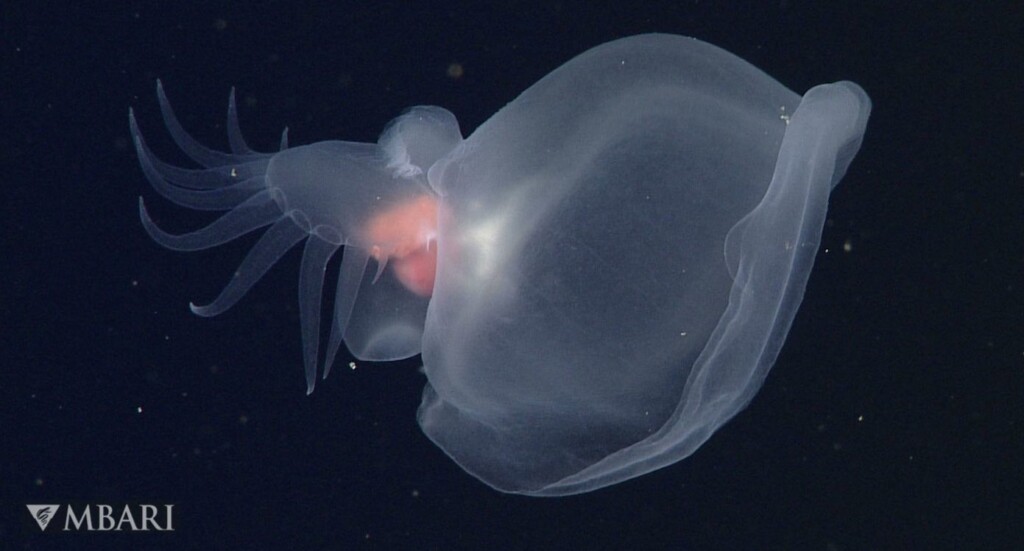 Newly described nudibranch, nicknamed ‘Mystery Mollusk’ – Credit: Monterey Bay Aquarium Research Institute
Newly described nudibranch, nicknamed ‘Mystery Mollusk’ – Credit: Monterey Bay Aquarium Research InstituteA remarkable new sea slug nicknamed the “mystery mollusk” has been discovered swimming deep in the ocean’s lightless zone.
The species has adaptations for life in the pitch-black depths including a large gelatinous hood to trap prey, a paddle-like tail, and the ability to light up, say American scientists.
The 5.6-inch (14.5-centimeter) hermaphrodite species, given the scientific name Bathydevius caudactylus, was discovered by marine biologists from Monterey Bay Aquarium Research Institute (MBARI) in California.
“Thanks to MBARI’s advanced underwater technology, we were able to prepare the most comprehensive description of a deep-sea animal ever made,” MBARI senior scientist Dr. Bruce Robison said. “We’ve invested more than 20 years in understanding the natural history of this fascinating species of nudibranch.”
MBARI researchers first observed the mystery mollusk in the year 2000 during a dive with the institute’s remotely operated vehicle (ROV) Tiburon offshore of Monterey Bay at 8,576 feet (2,614 meters) deep.
After reviewing more than 150 sightings from ROVs over the past 20 years, they have published a detailed description of the creature in the journal Deep-Sea Research.
With a voluminous hooded structure at one end, a flat tail fringed with numerous finger-like projections at the other, and colorful internal organs in between, the team initially struggled to place the animal in a group.
Because it also had a foot like a snail, they nicknamed it the “mystery mollusck.” After gently collecting a specimen, MBARI researchers were able to take a closer look at the animal in the lab and confirm that it is, in fact, a sea slug, or nudibranch.
MORE DEEP-SEA LIFE TO THRILL: Rare Deep Sea Squid with ‘Headlights’ Captured on Video–Mistaking the Camera for Food–WATCH
They are commonly found in coastal environments—such as tide pools, kelp forests, and coral reefs—and a few species are known to live on the abyssal seafloor. Some live in open waters near the surface, belying their colloquial name.
But Bathydevius caudactylus is the first nudibranch known to live in the midnight zone, an expansive environment of open water 3,300 to 13,100 feet below the surface, also known as the bathypelagic zone.
The B. caudactylus is currently known to live in the waters offshore of the Pacific coast of North America, with sightings on MBARI expeditions as far north as Oregon and as far south as Southern California.
MORE DEEP-SEA LIFE TO CHILL: Rare ‘Doomsday’ Fish Surfaces in California–Just the 20th Discovered in the State Since 1901
While most sea slugs use a rough tongue to feed on prey attached to the seafloor, B. caudactylus uses a cavernous hood to trap crustaceans like a Venus fly trap plant. A number of other unrelated deep-sea species use such a feeding strategy, including some jellies, anemones, and tunicates.
To avoid being eaten, it hides in plain sight with a transparent body. If discovered, it can light up with bioluminescence to deter and distract hungry predators. On one occasion, researchers saw it illuminate and then detach a steadily glowing finger-like projection from the tail, likely serving as a decoy to distract a potential predator.
“When we first filmed it glowing with the ROV, everyone in the control room let out a loud ‘Oooooh!’ at the same time,” said MBARI senior scientist Dr. Steven Haddock. “We were all enchanted by the sight.”
“Only recently have cameras become capable of filming bioluminescence in high-resolution and in full color. MBARI is one of the only places in the world where we have taken this new technology into the deep ocean, allowing us to study the luminous behavior of deep-sea animals in their natural habitat,” the appropriately named Haddock, added.
To date, MBARI technology has been used to document more than 250 deep-sea species previously unknown to science, but Haddock says B. caudactylus represents a “unique” find among them.
MONTERREY BAY WORK: Amazing Video of Giant Phantom Jellyfish from Deep in the Dark Fathoms at 3,200 Feet – WATCH
“For there to be a relatively large, unique, and glowing animal that is in a previously unknown family really underscores the importance of using new technology to catalogue this vast environment,” he said. “The more we learn about deep-sea communities, the better we will be at ocean decision-making and stewardship.”
SHARE This Great Deep Sea Discovery With Your Friends…
Source link

